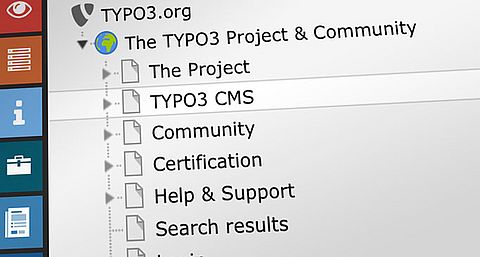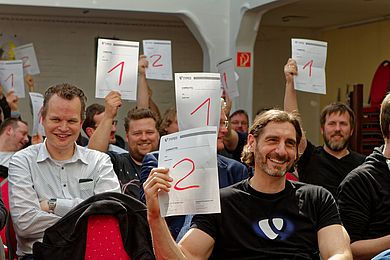TYPO3 core development is organised into Strategic Initiatives where people with common interests and skills can improve a specific area of TYPO3 together.
The goal of the TYPO3 Structured Content Initiative is to create a better experience for editors to work with content types and to help integrators build such content types easily, semantically correct, flexible and re-usable.
- Find out more about the group and activities on the Structured Content Initiative page
- Visit the the official TYPO3 Slack channel #cig-structuredcontent. Here’s how to connect to TYPO3 Slack.
Structured Team for a Structured Initiative
Structured content is one of the central features of TYPO3 and it affects all aspects of content management. Because many people are passionate about this topic, this group has attracted many ready to help out. To divide up the work, we established the following subtopics each with a unique focus:
- Editing Interface UX: creating personas, getting users feedback through surveys, building user stories, benchmarking other CMS, creating wireframes, mockups and layouts
- Content Block Creation: collecting developer’s and integrator’s pain points, building a content block registration process, then a content block registration API, evaluating processes for storing and connecting data, evaluating good practices for a better documentation
- Rendering Group: creating concepts for CSS and JavaScript registration per content block, creating concepts for data rendering in other formats than HTML
However, it doesn't cover all the tasks, and these groups will also have to work in cooperation with other teams and initiatives, such as the "Datahandler & Persistence Initiative" for example.
Alone We Go Faster, Together We Go Further...
When there are more members it multiplies the interactions, we have to be careful to make collegial decisions. The different groups have to keep each other informed of their progress and discoveries, it all takes time. So it's true, we would like to go faster, but until today, we have never regretted the time used to do things right, because we obtained quality results, and we know that on this topic, expectations are high, we must not go in the wrong direction.
In order to keep a steady rhythm, we hold a monthly Slack call per group, and one call across groups to keep everyone informed.
How You Can Help Right Now: Take and Share the Survey!
As part of our research into the user experience for TYPO3 end-users and content editors, we’ve prepared a survey. This survey is intended to determine the most common use cases when creating content with TYPO3, in order to optimize the corresponding user experience. It will take about 15 mins to complete.
Share the survey with colleagues and customers to ask them about their user experience when content editing in TYPO3.
What Have We Done so Far?
To improve TYPO3 content editor user experience we have to understand it. To that end, we’ve developed personas, built the survey, and also researched the wider market looking at other content management systems. We’ve used our findings to create a roadmap for feature improvements. Since last year, here’s the progress we’ve made.
Personas: We have built personas by paying attention to the representativeness of gender, level of education, country, etc. They represent editors, integrators, developers, translators and have character attributes based on popular personality types to make them easy to relate to. We will quickly make these personas available to other initiatives, in order to save their time and allow them to focus on the users expectations and not their background.
Market research: We have benchmarked several CMS (Open Source and not) and wrote our conclusions about their benefits or weaknesses in comparison with TYPO3 regarding the interfaces and the process of creating content in pages. Based on these conclusions we started to draw some mockups representing first tracks for the future interface of the page module.
A roadmap for improvements: Based on developer’s and integrator’s pain points we collected and ranked during the Initiative Week, we created a roadmap for the content block registration, maintenance and data storage. We have investigated several approaches of loading and including CSS and JavaScript such as concatenation, lazy loading and delivering them inline while also respecting aspects like page speed, loading order and common dependencies. On top of that, we’re looking at further topics like pre- and post-processing to support a wider range of front end technologies.
Content block registration: A technical draft of the content block registration process is currently in getting finalized. Head over to GitHub and “Star” and Watch the Structured Content Initiative GitHub repository to be notified as soon as the updates are published..
Documentation: During the TYPO3 Initiative Week we worked on the documentation for content element registration as well as improvements of existing and creation of new DataProcessors.
The Next Steps
We will analyse the survey results and publish them. The personas and results of the survey will be used to write our user stories using a template we have already prepared. Based on these user stories, we will resume work on the wireframes, mockups and other prototypes, and then select the solutions that we think are the best.
Once a proof of concept of content block registration process evaluates positive, the next big step will be an API.
Easy Ways to Improve Content Editing UX in TYPO3
Here’s how to get involved in this great initiative.
- Tell us about your challenges, wishes and ideas, come into the Slack channel: #cig-structuredcontent
- Share our survey with your editors.
- Star and watch the TYPO3 Structured Content repository on GitHub to be notified of updates.
- Test it! Once the concept for content block registration is published: review it on GitHub or even fork the repository and create own packages for proof of concept.
- Join our calls on Slack (#cig-structuredcontent) and become a member!
The Structured Content Initiative Team.
Proofreading: Heather McNamee




